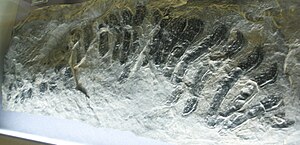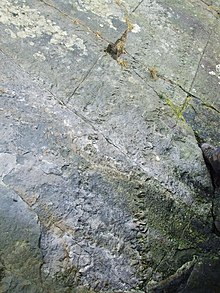Arthropleura
| Arthropleura | ||||||||||||
|---|---|---|---|---|---|---|---|---|---|---|---|---|

Remains of the back skeleton of Arthropleura armata in the Senckenberg Museum in Frankfurt am Main . |
||||||||||||
| Temporal occurrence | ||||||||||||
| Top viséum to Unterperm | ||||||||||||
| 332 to 290 million years | ||||||||||||
| Locations | ||||||||||||
| Systematics | ||||||||||||
|
||||||||||||
| Scientific name | ||||||||||||
| Arthropleura | ||||||||||||
| Jordan & von Meyer 1854 | ||||||||||||
| species | ||||||||||||
|
Arthropleura is a genus of extinct land-dwelling arthropods from the late Paleozoic of North America and Europe. It isprovenfrom the uppermost viséum (upper lower carbon ) to the lower permeate. The representatives of this genus reached a length of up to 2.5 meters, making them the largest arthropods ever to live. Due to their size, they were in competition with the contemporary land vertebrates (Tetrapoda). Your closest living relatives are believed to be the millipedes (Myriapoda).
The Arthropleura armata species was voted Fossil of the Year 2015 by the Paleontological Society .
anatomy
The exoskeleton consisted of about 32 body segments, each with a pair of legs. The largest body segments were 48 centimeters wide. The body size is probably due to the high oxygen content of 35% and the high humidity in the fern forests of the Carboniferous due, which in many arthropods with an almost completely passive transport of air through trachea promoted a gigantism inside the body.

Way of life
The ecology of Arthropleura can primarily be inferred from the properties of the sedimentary rocks in which corresponding body and trace fossils were found. These rocks were roughly equally as original deposits of swamp forests ( " coal forests") and lowlands interpreted. On the other hand, no reliable statements can be made about eating habits, especially because the underside of the head and the chewing apparatus are still completely unknown. The reason for this is probably that almost all of the body fossils of Arthropleura are not the remains of dead animals, but rather the remains of molting, so-called exuvia . This is probably one of the reasons why no specimens of arthropleura including the fossilized gastric contents have been found so far . In 1967, a juvenile individual was found to be found together with the remains of Bärlapp trees, but a re-examination in the 2000s revealed that it was not the stomach contents, but plant material that happened to have been handed down with the animal remains. Fossil stomach contents could provide relatively certain information about whether Arthropleura was a herbivore or a predator.
Occurrence
Arthropleural fossils are found in the deposits of Carboniferous and sub-Permian coal swamps. There they have been found both in Europe (Great Britain, France, Germany, Poland, the Czech Republic) and in North America (Pennsylvania, Ohio, Illinois, Nova Scotia). The species Arthropleura cristata comes from the famous fossil deposits on Mazon Creek in Illinois. The relatively small type -Art Arthropleura armata , whose remains in the Saar-Nahe Basin were found, has a length of only one meter. Other sites of the genus on German soil can be found near Freital in the Döhlener basin , as well as in Manebach near Ilmenau in the Thuringian Forest . The arthropleural remains found in Chemnitz-Borna-Heinersdorf in the Variscan Early Molasse ( Viséum , higher Lower Carboniferous, about 332 million years old) of the Hainichen Basin are the earliest evidence to date. The most recent safe find to date also comes from Chemnitz, namely from the Zeisigwald tuff (lower Unterperm, about 291 million years old), where the famous petrified forest has been handed down.
Trivia
Arthropleura played a role in the British television series Prehistoric Park - Extinction was yesterday and Primeval - Return of the primeval monsters as well as in the movie In the Land of the Dinosaurs (Australia, 2014). The portrayal of Arthropleura in all of these productions, especially in Primeval, only partially corresponds to reliable scientific findings or contains purely speculative aspects and is primarily intended to entertain the audience.
Web links
- Poisonous limb monster - In Thuringia, researchers discovered the remains of the largest millipede of all time. Background report by Urs Willmann on zeit.de from May 6, 1999 on the discovery of arthropleura in the Manebach formation in the Thuringian Forest.
- A primal being takes shape - contribution to the unraveling of a giant arthropod from the coal era at the Institute of Geology and Paleontology. ( Memento from June 11, 2007 in the Internet Archive ) HTML version of an article about Arthropleura armata by the paleontologists Carsten Brauckmann and Elke Gröning in TUContact 2/1998 (University magazine of the TU Clausthal)
- Gigantism, flying and antiaging: oxygen-rich air triggered a surge in innovation 300 million years ago. Article by Marcel Falk on Wissenschaft.de (Bild der Wissenschaft) from June 27, 2003 about the suspected causes of the giant growth in carbon arthropods
Individual evidence
- ↑ Hermann Jordan, Hermann von Meyer: About the Crustaceans of the coal formation of Saarbrücken. In: Palaeontographica. Vol. 4, 1854, pp. 1–15 ( Wikisource )
- ↑ Simon J. Braddy, Markus Poschmann, O. Erik Tetlie: Giant claw reveals the largest ever arthropod . In: Biology Letters . tape 4 , no. 1 , 2008, p. 106-109 , doi : 10.1098 / rsbl.2007.0491 .
- ↑ Jörg W. Schneider, Ralf Werneburg: Arthropleura, the largest land-living arthropod in the history of the earth - new finds and new ideas . In: Semana - scientific publications of the Natural History Museum Schloss Bertholdsburg Schleusingen . tape 25 , 2010, p. 61-86 .
- ^ Fossil of the year 2015 - Arthropleura armata. Website of the Paleontological Society.
- ^ JF Harrison, A. Kaiser, JM VandenBrooks: Atmospheric oxygen level and the evolution of insect body size . In: Proceedings of the Royal Society B: Biological Sciences . tape 277 , no. 1690 , 2010, p. 1937–1946 , doi : 10.1098 / rspb.2010.0001 .
- ^ DEG Briggs, WDI Rolfe, J. Brannan: A Giant Myriapod Trail from the Namurian of Arran, Scotland. In: Paleontology. Vol. 22, No. 2, 1979, pp. 273–291 ( PDF 3.0 MB)
- ↑ a b c d e J. W. Schneider, SG Lucas, R. Werneburg, R. Rößler: Euramerican Late Pennsylvanian / Early Permian Arthropleurid / Tetrapod Associations - Implications for the Habitat and Paleobiology of the Largest Terrestrial Arthropod. In: SG Lucas, JW Schneider, JA Spielmann (eds.): Carboniferous-Permian transition in Canon del Cobre, northern New Mexico. New Mexico Museum of Natural History and Science Bulletin. Vol. 49, 2010, pp. 49-70. ( PDF 7.9 MB)
- ^ Eugene S. Richardson: Pennsylvanian invertebrates of the Mazon Creek area, Illinois. Trilobitomorpha: Arthropleurida, II. In: Fieldiana Geology. Vol. 12, No. 5, 1959, doi : 10.5962 / bhl.title.3281
- ↑ Ronny Rößler, Ludwig Luthardt, Jörg W. Schneider: The Petrified Forest Chemnitz - Snapshot of a volcanically preserved ecosystem from the Permian. In: Annual reports and communications of the Upper Rhine Geological Association, NF Vol. 97, 2015, pp. 231–266, doi: 10.1127 / jmogv / 97/0011 (alternative full text access: ResearchGate ).
- ↑ Article Arthropleura from the Prehistoric Park Wiki. Retrieved December 19, 2012.
- ↑ Article Arthropleura from the Primeval Wiki. Retrieved December 19, 2012.
Further literature sources
- G. Pacyna, S. Florjan, R. Borzęcki: New morphological features of Arthropleura sp. (Myriapoda, Diplopoda) based on new specimens from the Upper Carboniferous of Lower Silesia (Poland) . In: Annales Societatis Geologorum Poloniae. Vol. 82, No. 2, 2012, pp. 121–126 ( online )

